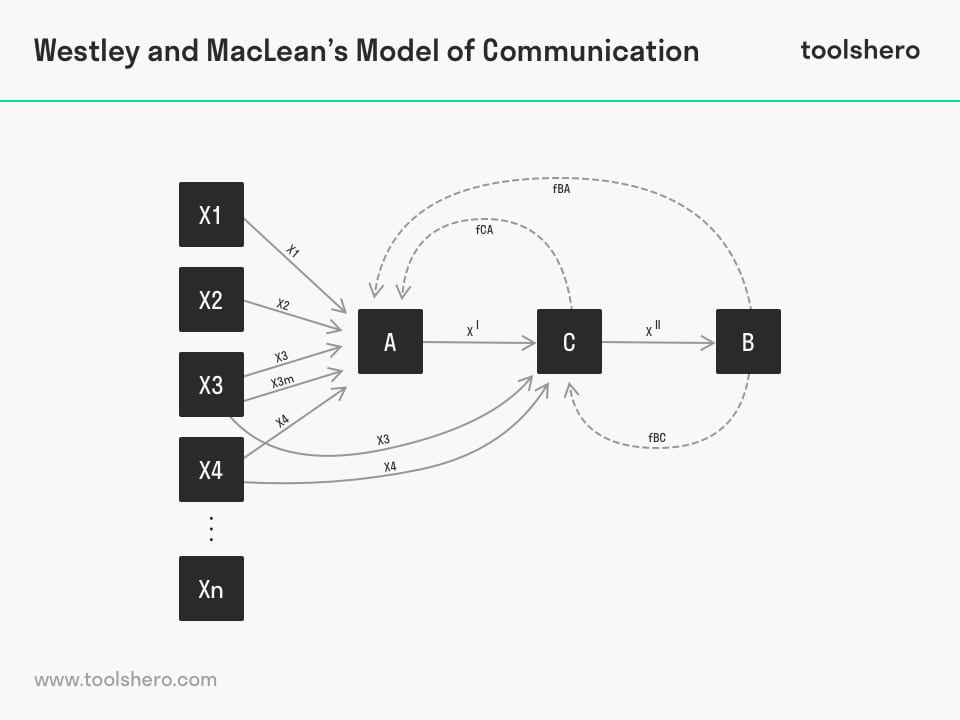Westley & MacLean Model of Communication

Westley & MacLean Model of Communication: this articles provides a practical explanation of the Westley & MacLean Model of Communication. Next to what it is, this article also highlights the interpreting the model, the components, the role of feedback and the advantages and disadvantages of this model. After reading, you will understand the basics of this communication theory. Enjoy reading!
What is the Westley & MacLean Model of Communication?
The Westley & MacLean Model of Communication analyses the communication between source and receiver, indicated as A and B. In addition, mass media are indicated with C. The model can thus be viewed from two perspectives, interpersonal and mass communication.
The difference between interpersonal communication and mass communication is the feedback. In mass communication, feedback is indirect and slow.
Contrary to the Artistotle communication model, or the communication cycle by Shannon & Weaver, the Westley MacLean Model of Communication inherently states that communication doesn’t start as soon as someone speaks, but rather when a person responds, or is looking for a reaction from the environment.
Westley & MacLean Model of Communication was introduced by Bruce Westley and Malcolm S. MacLean junior. Westley was a professor at the University of Wisconsin and Malcolm was a director of the University of Jouralism School. The model was based on the Newcomb co-orientation model.
Interpreting the Westley & MacLean Model of Communication correctly
Westley & MacLean Model of Communication doesn’t start as soon as a person starts talking or sends a message, but rather shows how a person reacts to his or her physical environment. The model shows a strong relationship between environmental factors and messages and the communication process.

Figure 1 – an example of communication (Westley & MacLean)
Components of the Westley & MacLean Model of Communication
Westley & MacLean Model of Communication consists of multiple components, which may sometimes cause confusion. However, the model is fairly easy to understand, as is explained per element below. Moreover, the elements are explained in the order in which they appear in contemporary communication.
Source (A)
The source is the person who creates and sends a message.
Environment (X)
The environment is the physical and psychological state in which the communication process is studied. This doesn’t necessarily have to be the same room. Modern communication is a global process, after all.
Sensory Experience (X1)
The sensory experience is the first thing the source sees that gives him/her the idea to write a message or comment.
Object of Orientation (X1, X2, …)
Objects of orientation can be many different things. They are what the source is exposed to, both in a social and cultural context. In practice, this may be newsletters or a religious book. The objects of orientation make a person the person they are.
Coding of Interpretation (X’)
The information is interpreted by the receiver. In other communication models, such as the Aristotle and Shannon & Weaver model, this component is referred to as decoding.
Receiver (B)
Within the Westley & MacLean Model of Communication, the receiver is the person who receives the message from the source, and is the person who interprets the message through the various objects of orientation.
Object of orientation receiver (X,b)
The beliefs and viewpoints of the receiver are also based on his or her past and objects of orientation. The way in which the information is interpreted is highly dependent on this.
Feedback (F)
Once the initial message has been received, the receiver sends a message back to the source. This message is also known as feedback. More about this crucial part of (interpersonal) communication later.
Gatekeepers (C)
Gatekeepers are present in mass communication. The gatekeeper is the person who ensures the message is filtered and tailored to the wishes of the public and media companies.
The Role of Feedback in Communication
Feedback is a given part of communication, and consists of a response from the receiver that reaches the sender after the message has been interpreted. Feedback is essential in making two-way communication possible and effective. Without feedback, there is no complete communication circle.
Feedback has the following functions in communication:
Collecting information
Since the receiver’s response is considered as feedback, feedback is the only way to obtain information from the receiver. If the receiver doesn’t return information, there is no other way of receiving information from this person.
Completing communication
Without feedback there is no (interpersonal) communication, and both the source and receiver can learn a lot from feedback.
Measuring the effectiveness of communication
Based on the feedback, the source can determine how well his or her message is understood, and how it will be used by the receiver. By analysing the response, the source can determine how effective communication has been and what can be improved next time.
Improving the employee-employer relationship
A good relationship between management and employees is essential to form a successful organisation. If management recognises the value of the Westley & MacLean Model of Communication, but also other models, then employees are encouraged to share their opinion and feelings.
Management must therefore actively encourage employees and gain information from them about the opinions and methods of business processes and culture. Feedback ensures a healthy working environment and good relationships between employees and management.
Supporting decision making
Based on the receiver’s response, the source may decide whether or not to adjust their message, or to actually execute what they suggested to the recipient, for example.
In the workplace, after the team leader has indicated that he is far behind schedule, a department head may decide to provide additional manpower. In other words, feedback helps managers make better decisions that provide extra value.
Resolving problems
Different problems occur in every organisation, and in many cases these must be solved adequately, quickly, and effectively. Two-way traffic in communication ensures that both the problem and solution are addressed.
During a strike, workers stop working and often demand better working conditions or a new collective labour agreement. Management will witness this strike, and then decide whether or not to discuss a solution with the workers.
Coordination
It goes without saying that there is communication between colleagues in a department. However, communication goes much further. It ensures that coordination of various departments and cooperation mechanisms continue to run smoothly. To encourage this cooperation, departments must communicate with internal and external parties.
Advantages and disadvantages of the Westley & MacLean Model of Communication
Westley & MacLean Model of Communication has several advantages and disadvantages:
Advantages of the Westley & MacLean Model of Communication
- The necessity and concept of feedback is reflected in the model
- The message comes from the environment, not necessarily a person. This guarantees multiple senses are involved in the process
- Social, cultural, and other factors also play a role as part of the objects of orientation
- The model can be applied to interpersonal communication, but also mass communication
Disadvantages of the Westley & MacLean Model of Communication
- The model consists of many components and variables, which make it appear complex
- The model does not address multiple or complex messages
- Information may be changed while it is being sent from the source to the receiver (noise), which the model does not address. The Shannon & Weaver model does address this, however
Now It’s Your Turn
What do you think? Are you familiar with the explanation of the Westley & MacLean Model of Communication? What do you believe are the pros and cons of this model? Do you see any similarities with other theories on communication? Do you have any tips or additional comments?
Share your experience and knowledge in the comments box below.
More information
- Lacy, S. (1989). The Westley-MacLean Model Revisited: An Extension of a Conceptual Model for Communication Research.
- McQuail, D., & Windahl, S. (2015). Communication models for the study of mass communications. Routledge.
- Westley, B. H., & MacLean, M. S. (1955). A conceptual model for communications research. Educational Technology Research and Development, 3(1), 3-12.
- Westley, B. H., & MacLean Jr, M. S. (1957). A conceptual model for communications research. Journalism Quarterly, 34(1), 31-38.
How to cite this article:
Janse, B. (2019). Westley & MacLean Model of Communication. Retrieved [insert date] from Toolshero: https://www.toolshero.com/communication-methods/westley-and-maclean-model-of-communication/
Published on: 11/21/2022 | Last update: 05/21/2022
Add a link to this page on your website:
<a href=”https://www.toolshero.com/communication-methods/westley-and-maclean-model-of-communication/”>Toolshero: Westley & MacLean Model of Communication</a>












